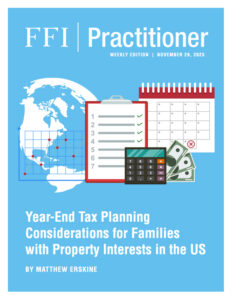
View this edition in our enhanced digital edition format with supporting visual insight and information.
As the end of the year is quickly approaching, this week’s contributor, Matthew Erskine, provides a checklist of tax planning items for family enterprise clients to consider. This article provides insights for advisors with family enterprise clients in the US or international families with property interests in the US.
The end of the year presents a strategic opportunity for family enterprise advisors to guide their clients in reviewing their wealth and estate planning strategies.
This is the perfect time for clients to reflect on their financial objectives and align them with their current and future financial commitments. Whether their interests lie in philanthropy, planning for generational business transitions, or navigating surplus wealth goals, effective year-end planning can help optimize their financial outlook.
For international advisors, this year-end planning holds additional significance, especially if their clientele includes individuals with financial interests in the US. In this case, it becomes paramount to navigate and strategize around the complexities of US income and transfer tax laws. Clients with cross-border financial implications can become subject to these US tax laws, and thus require meticulous planning to minimize potential tax liabilities. International family enterprise advisors, therefore, play a crucial role in equipping their clients with the necessary information and strategies to effectively manage their wealth and estate amidst a challenging global tax landscape.
Checklists of Key Considerations for Year-End Tax Planning for International Advisors
While not exhaustive, the lists below include the most important year-end tax planning considerations.
Gift and Estate Tax Planning
✓ Gift/Estate Tax Exemption: Starting in 2023, clients can take advantage of a lifetime exemption of $12.92 million to protect transfers from estate and gift tax. The tax rate for these transfers is 40 percent for assets that exceed this exemption. For married couples, the exemption doubles to $25.84 million. The IRS has come out with the new individual exemption amount for 2024—$13,610,000—which means that clients could give an additional $690,000 on or after January 1, 2024. These exemption amounts also apply to the generation-skipping transfer (GST) tax. For international families, the estate tax and exemptions apply to real and tangible property (including business assets) located in the US.
✓ Lifetime Gifting: Encourage US clients, and international clients looking to reduce the potential tax burden on property located in the US, to consider making strategic gifts during their lifetime to remove the future appreciation of assets from the taxable estate. These gifts can take various forms, such as outright gifts, funding trusts, or adding to existing trusts using different types of assets. Leveraging gifts through valuation discounts can be beneficial, especially for assets that are not easily marketable or where the donor lacks control.
✓ Annual Gifting Exclusion: Inform clients that each person can gift up to $17,000 annually to another person without affecting their lifetime exemption on property held in the US ($34,000 for married couples) in 2023. This amount is increased to $18,000 for 2024. Educate clients on options for making these gifts directly or into trusts, custodial accounts, or 529 college savings plans, and mention the possibility of frontloading up to five years’ worth of annual exclusions through 529 plans.
✓ Spousal Lifetime Access Trusts (SLATs): Highlight the advantages of SLATs for clients who are cautious about gifting too much. SLATs allow one spouse to access the trust if needed, providing a safety net while still taking advantage of the tax exemption.
✓ Tax Cuts and Jobs Act: Remind clients that the gift and estate tax exemption doubled in 2018, but it is set to decrease in 2026 unless Congress acts. Clients who have the means to make significant gifts are advised to do so before the potential decreases take effect.
✓ Direct Payment of Tuition and Medical Expenses: Encourage family enterprise clients to learn more about the strategy of making direct payments for tuition and medical expenses, which are not considered taxable gifts and do not use any portion of the exemption amount, regardless of the beneficiary’s relationship to the payer.
By addressing or introducing these considerations, advisors can help their clients with property interests in the US navigate year-end gift and estate tax planning with confidence and optimize their financial strategies for the future.
Income Tax Planning
✓ Tax Loss Harvesting: As advisors, it’s important to recommend the strategy of selling investments at a loss to offset capital gains. This can significantly reduce taxable income for clients. Remember, if losses exceed gains, clients can use up to $3,000 to offset ordinary income, with the remaining losses carried forward to future years.
✓ Roth IRA Conversion: Educating clients about transitioning from a traditional or employer-sponsored IRA to a Roth IRA is essential. During market downturns, this conversion can be highly beneficial. However, it’s important to carefully consider the tax implications and guide clients through the process, ideally with the assistance of an accountant. Remind them of the advantage of tax-free withdrawals in the future, without any required minimum distributions (RMDs).
✓ Charitable Planning: Advisors play a crucial role in guiding clients towards making end-of-year charitable contributions. Highlight the tax benefits of donating appreciated securities, which can help clients avoid capital gains tax. Discuss the various options, such as contributing directly to a charity or utilizing Donor-Advised Funds (DAFs), private foundations, or charitable trusts. The method of giving can impact tax deductibility limits, and consolidating contributions into a single year can maximize overall tax savings. Collaborating with an accountant can ensure clients effectively maximize these deductions.
Year-End Planning in a High-Interest-Rate Environment: Advice for Advisors
When it comes to estate planning, it’s important to consider the impact of inflation and rising interest rates driven by Federal Reserve policies. These rate changes have significant implications for estate planning vehicles, such as Applicable Federal Rates (AFRs) and the 7520 rate (GRAT hurdle rate).
As advisors, it’s crucial to understand the effects of higher interest rates on estate planning techniques. The valuation of split-interest gifts, like QPRTs (qualified personal residence trusts), CRTs (charitable remainder trusts), and GRATs (grantor retained annuity trusts), is directly influenced by these interest rates. In a high-interest environment, higher rates can reduce the taxable value of the gift, allowing for more favorable utilization of the gift tax exemption.
Below is a non-exhaustive list of estate planning strategies for a high-interest-rate environment.
Specific Strategies for Advisors to Consider
QPRTs and CRTs: QPRTs enable the transfer of a qualified personal home into a trust, with the grantor retaining the right to live there for a designated period before gifting it to beneficiaries. Higher interest rates may result in a reduced taxable value, enhancing the benefits of this strategy. QPRTs are available to non-US citizens who have purchased a residence in the US.
CRTs provide an income stream for beneficiaries, with the remainder going to charity. With higher interest rates, the charitable deduction increases, making CRTs advantageous. Funding CRTs with low-basis assets maximizes the deduction without triggering a gain.
Intra-Family Loans and GRATs: Despite high AFRs, intra-family loans can still be advantageous, as they may offer lower rates than commercial options and provide family members with access to liquidity.
GRATs allow for the transfer of asset appreciation to beneficiaries without incurring gift tax, provided the appreciation exceeds the hurdle rate. While they may be less appealing in a high-rate environment, GRATs remain useful, particularly for those who have already utilized their exemption limits.
Planning Opportunities
Despite the challenges posed by a high-interest-rate environment, there are planning opportunities that can benefit tax and estate considerations. As family enterprise advisors, it’s important to discuss these opportunities with your clients to optimize year-end planning strategies.
While a high-interest-rate environment presents its own set of challenges, it also opens the door to unique tax and estate planning opportunities for US clients and international clients with property in the US. Levers such as QPRTs, CRTs, intra-family loans, and GRATs can be strategically used to maximize advantages and mitigate tax implications.
Trusted advisors to families of wealth should strive to remain nimble and adaptive, navigating through the complexities of the financial landscape to provide personalized strategies that align with the evolving needs and financial goals of their clients.
–
Disclaimer: The views expressed in this article are those of the author only. The information contained in this article is provided solely for informational purposes. This article does not constitute legal or tax advice or create an attorney-client relationship.
About the Contributor

Matthew Erskine is the managing partner of Erskine & Erskine LLC, a fourth-generation law firm, and The Erskine Company, LLC, a consulting firm. He focuses on strategic planning and legal services for business owners, professionals, individuals, families, collectors, and inheritors of unique assets, helping his clients and their families solve their problems through customized estate, tax, and management solutions. Matthew can be reached at m.erskine@erskineco.com.

View this edition in our enhanced digital edition format with supporting visual insight and information.





